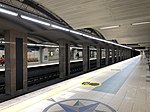Estaus Palace
AC with 0 elementsFormer buildings and structures in PortugalHistory of LisbonNeoclassical architecture in PortugalPalaces in Lisbon ... and 1 more
Portuguese Inquisition

The Estaus Palace (Portuguese: Paço dos Estaus; Palácio dos Estaus) in Rossio Square, in Lisbon, was the headquarters of the Portuguese Inquisition. The original palace was built on the north side of the square around 1450 as lodging for foreign dignitaries and noblemen visiting Lisbon.
Excerpt from the Wikipedia article Estaus Palace (License: CC BY-SA 3.0, Authors, Images).Estaus Palace
Praça Dom Pedro IV, Lisbon Santa Maria Maior (Santa Maria Maior)
Geographical coordinates (GPS) Address Nearby Places Show on map
Geographical coordinates (GPS)
| Latitude | Longitude |
|---|---|
| N 38.7148 ° | E -9.1398 ° |
Address
Teatro Nacional Dona Maria II (Teatro Nacional de Almeida Garrett)
Praça Dom Pedro IV 1
1100-201 Lisbon, Santa Maria Maior (Santa Maria Maior)
Portugal
Open on Google Maps










